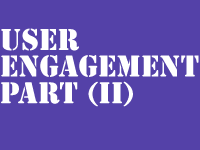
User Experience (UX) and Improving Engagement
12 July 2009, Rupert Hughes
 From the moment a user clicks on your perfectly crafted, scent-rich link the engagement clock (actually more of a stopwatch) is ticking.
From the moment a user clicks on your perfectly crafted, scent-rich link the engagement clock (actually more of a stopwatch) is ticking.
Following on from last week’s post on how user experience (UX) affects online customer acquisition, this week’s looks at the next stage in the online customer journey: Engagement.
What is user engagement?
This is the ephemeral process taking place inside a user’s head within the first few seconds of clicking a link which decides whether they stay with you or click “Back” to find a better answer to their query.
In websites, as in real life, first impressions matter.
Engagement is at work before a user even reaches your site. They’ll already have some expectations of success set up by the content of the link they’ve clicked on or their previous experience with your brand, so the page they land on had better meet those expectations or they’ll be off. In the approximate order that they affect users, here are the UX engagement factors for those first few seconds:
Download speed
OK, so most of your users now have broadband, but that’s no excuse for a page that’s so bloated with stylesheets and javascript that it takes 5 seconds to download. That might have been acceptable when the internet resounded to the whistles and beeps of the 56k modem, but the broadband surfer demands instant gratification and that means being able to interact with the page within a second.
Design
Design matters and human beings absorb design factors at a subliminal level. Usability gurus sometimes argue that users are only after information and design is secondary, but this ignores the fact that users register a site’s design first and a good design influences the mood and attitude with which they then approach the content.
At a Microsoft conference a while back I attended a seminar on the concept of Positive Affect. This is the idea that attractive things appear to work better. In a small experiment two groups of people were asked to use a particularly nasty town council website. In one group a happy mood was induced. When asked to score their experience of the site, the happy group scored it significantly higher than the control group. There’s more detail in the presentation (PDF) from slide 77 (Warning: large download).
Design also influences your credibility. If your site looks like your nephew’s year 3 art project then don’t expect anyone to take it seriously (unless perhaps you’re marketing to primary schools) and expect to lose lots of users before they even read your content.
Content
Assuming you’ve got through the design gate, then your content comes into play. Remember that we’re still in the first few seconds of user interaction, so the layout and structure of your content will be as important as what it actually says.
Users scan web pages so your content needs to be structured to help draw the eye to what you want to talk about. What you’re actually trying to do is encourage users to fixate on a piece of your content so that they start reading instead of scanning. Keep paragraphs short and use sub-headings, bulleted and numbered lists, emboldened words, and writing techniques like showing numbers as numerals.
In the Engagement phase, the bit of text content users are most likely to read is your h1 page heading and this is a moment when SEO and UX are perfectly in tune. For good SEO your h1 text needs to reflect and support your page title which works brilliantly for UX, because the title is the link that users have clicked on to get to you. Their expectations are therefore set by the content of that link and if the first piece of text they read on arrival supports and reflects the link they clicked, then they’re more likely to engage with the site.
Only when you’ve engaged your users can your site start to work on converting them to a customer or a reader. How
UX affects this stage will be the subject of next week’s post.
This article was written by Rupert Hughes – managing consultant at Firehorse Digital.


